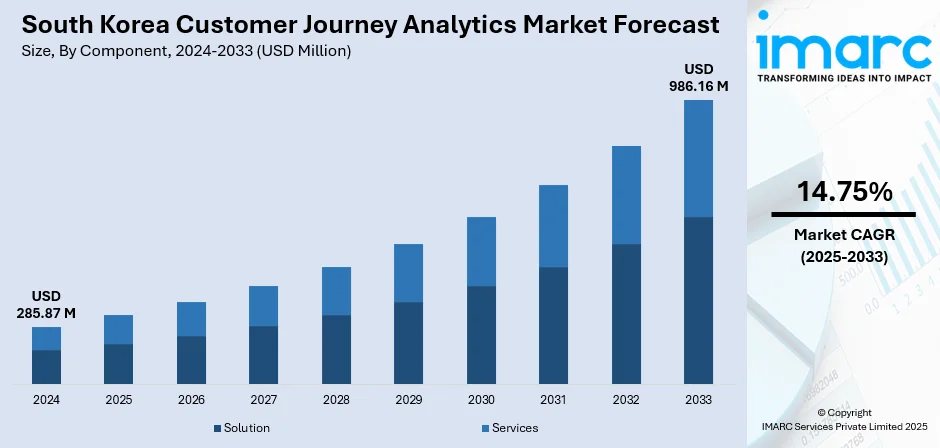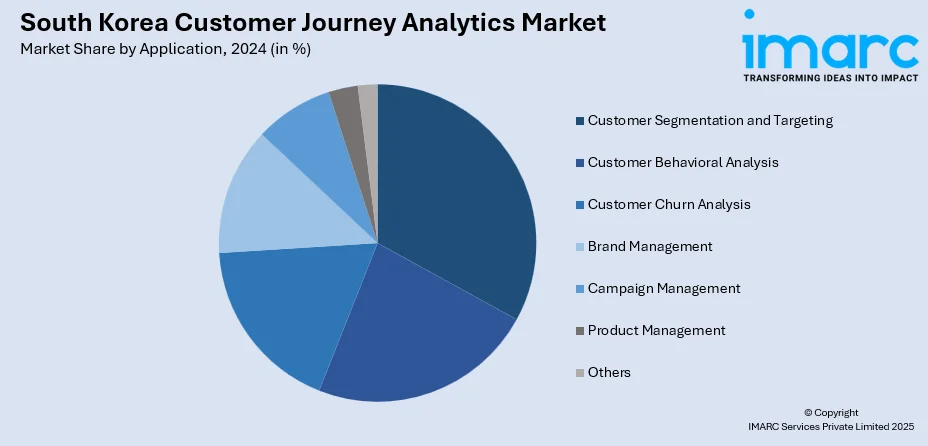
South Korea Customer Journey Analytics Market Size, Share, Trends and Forecast by Component, Touchpoint, Deployment, Organization Size, Application, Industry Vertical, and Region, 2025-2033
South Korea Customer Journey Analytics Market Overview:
The South Korea customer journey analytics market size reached USD 285.87 Million in 2024. The market is projected to reach USD 986.16 Million by 2033, exhibiting a growth rate (CAGR) of 14.75% during 2025-2033. The market is fueled by the rapid digital transformation across industries in South Korea, prompting businesses to adopt advanced analytics for understanding and optimizing customer interactions. Moreover, the growing investments in AI, big data, and cloud technologies are enabling companies to gain real-time insights, personalize engagement strategies, and enhance customer retention. Additionally, the rising demand for omnichannel experiences are further augmenting the South Korea customer journey analytics market share.
|
Report Attribute
|
Key Statistics
|
|---|---|
|
Base Year
|
2024
|
|
Forecast Years
|
2025-2033
|
|
Historical Years
|
2019-2024
|
| Market Size in 2024 | USD 285.87 Million |
| Market Forecast in 2033 | USD 986.16 Million |
| Market Growth Rate 2025-2033 | 14.75% |
South Korea Customer Journey Analytics Market Trends:
Integration of AI and Machine Learning in Customer Journey Mapping
In South Korea, businesses are increasingly integrating artificial intelligence (AI) and machine learning (ML) technologies into customer journey analytics to enhance precision and automation. This trend is driven by the need to process vast amount of structured and unstructured customer data from multiple touchpoints in real time. AI algorithms enable organizations to identify patterns in consumer behavior, predict future actions, and deliver hyper-personalized experiences. Machine learning models are particularly valuable for segmenting customer profiles, detecting churn risks, and optimizing marketing campaigns. As South Korean consumers exhibit high digital maturity and rapidly shifting expectations, the ability to react dynamically to behavioral signals becomes a competitive necessity. Additionally, domestic tech providers and telecom companies are collaborating to offer AI-powered analytics platforms tailored to local businesses. Government-led digital transformation initiatives also support AI adoption, positioning the technology as a cornerstone of customer experience strategies across sectors such as finance, retail, and telecommunications.

To get more information on this market, Request Sample
Growing Emphasis on Omnichannel Analytics for Seamless Experience
With South Korea’s population ranking among the most digitally connected in the world, businesses are prioritizing omnichannel analytics to deliver seamless and cohesive customer experiences across physical and digital platforms. Consumers in the country frequently switch between channels, such as e-commerce sites, brick-and-mortar stores, mobile apps, chatbots, and call centers, making it essential for companies to monitor and unify these interactions into a single journey view. Omnichannel customer journey analytics tools help organizations understand how users navigate across platforms, which touchpoints lead to conversions, and where drop-offs occur. The rise of hybrid retail and phygital engagement in South Korea has further intensified the need for synchronized insights across sales, marketing, and customer service functions. Retail, finance, and travel sectors are investing heavily in platforms that integrate real-time behavioral tracking with customer relationship management (CRM) and enterprise resource planning (ERP) systems. The aim is to facilitate contextual responses and eliminate friction in the buyer’s journey, ultimately driving loyalty and repeat engagement.
Increased Adoption of Real-Time Analytics and Personalization
The surge in the adoption of real-time customer journey analytics, driven by the demand for instant, context-aware personalization, is positively impacting the South Korea customer journey analytics market growth. As consumers expect immediate responses and tailored offerings, businesses are leveraging real-time data processing to adapt messaging, recommendations, and service interventions on the fly. Technologies such as event stream processing, edge computing, and advanced dashboards allow companies to analyze customer interactions as they happen, whether during a live chat session, website visit, or mobile app usage. This trend is particularly prominent in sectors such as e-commerce, telecommunications, and digital banking, where customer decisions occur in fast-paced, high-touch environments. Real-time insights also support adaptive customer journey orchestration, enabling brands to shift communication flows or trigger targeted promotions based on evolving behavior. Moreover, South Korea’s competitive technology landscape and high internet penetration support the widespread use of APIs and data integration tools, which are crucial for enabling real-time data flows across marketing, support, and sales ecosystems.
South Korea Customer Journey Analytics Market Segmentation:
IMARC Group provides an analysis of the key trends in each segment of the market, along with forecasts at the country and regional levels for 2025-2033. Our report has categorized the market based on component, touchpoint, deployment, organization size, application, and industry vertical.
Component Insights:
- Solution
- Services
The report has provided a detailed breakup and analysis of the market based on the component. This includes solution and services.
Touchpoint Insights:
- Web
- Social Media
- Mobile
- Branch and Store
- Call Center
- Others
A detailed breakup and analysis of the market based on the touchpoint have also been provided in the report. This includes web, social media, mobile, email, branch and store, call center, and others.
Deployment Insights:
- On-premises
- Cloud-based
The report has provided a detailed breakup and analysis of the market based on the deployment. This includes on-premises and cloud-based.
Organization Size Insights:
- Large Enterprises
- Small and Medium-sized Enterprises
A detailed breakup and analysis of the market based on the organization size have also been provided in the report. This includes large enterprises and small and medium-sized enterprises.
Application Insights:

- Customer Segmentation and Targeting
- Customer Behavioral Analysis
- Customer Churn Analysis
- Brand Management
- Campaign Management
- Product Management
- Others
The report has provided a detailed breakup and analysis of the market based on the application. This includes customer segmentation and targeting, customer behavioral analysis, customer churn analysis, brand management, campaign management, product management, and others.
Industry Vertical Insights:
- BFSI
- IT and Telecommunications
- Retail and E-Commerce
- Healthcare
- Media and Entertainment
- Travel and Hospitality
- Others
A detailed breakup and analysis of the market based on the industry vertical have also been provided in the report. This includes BFSI, IT and telecommunications, retail and e-commerce, healthcare, media and entertainment, travel and hospitality, and others.
Regional Insights:
- Seoul Capital Area
- Yeongnam (Southeastern Region)
- Honam (Southwestern Region)
- Hoseo (Central Region)
- Others
The report has also provided a comprehensive analysis of all the major regional markets, which include Seoul Capital Area, Yeongnam (Southeastern Region), Honam (Southwestern Region), Hoseo (Central Region), and others.
Competitive Landscape:
The market research report has also provided a comprehensive analysis of the competitive landscape. Competitive analysis such as market structure, key player positioning, top winning strategies, competitive dashboard, and company evaluation quadrant has been covered in the report. Also, detailed profiles of all major companies have been provided.
South Korea Customer Journey Analytics Market Report Coverage:
| Report Features | Details |
|---|---|
| Base Year of the Analysis | 2024 |
| Historical Period | 2019-2024 |
| Forecast Period | 2025-2033 |
| Units | Million USD |
| Scope of the Report |
Exploration of Historical Trends and Market Outlook, Industry Catalysts and Challenges, Segment-Wise Historical and Future Market Assessment:
|
| Components Covered | Solution, Services |
| Touchpoints Covered | Web, Social Media, Mobile, Email, Branch and Store, Call Center, Others |
| Deployments Covered | On-premises, Cloud-based |
| Organization Sizes Covered | Large Enterprises, Small and Medium-sized Enterprises |
| Applications Covered | Customer Segmentation and Targeting, Customer Behavioral Analysis, Customer Churn Analysis, Brand Management, Campaign Management, Product Management, Others |
| Industry Verticals Covered | BFSI, IT and Telecommunications, Retail and E-Commerce, Healthcare, Media and Entertainment, Travel and Hospitality, Others |
| Regions Covered | Seoul Capital Area, Yeongnam (Southeastern Region), Honam (Southwestern Region), Hoseo (Central Region), Others |
| Customization Scope | 10% Free Customization |
| Post-Sale Analyst Support | 10-12 Weeks |
| Delivery Format | PDF and Excel through Email (We can also provide the editable version of the report in PPT/Word format on special request) |
Key Questions Answered in This Report:
- How has the South Korea customer journey analytics market performed so far and how will it perform in the coming years?
- What is the breakup of the South Korea customer journey analytics market on the basis of component?
- What is the breakup of the South Korea customer journey analytics market on the basis of touchpoint?
- What is the breakup of the South Korea customer journey analytics market on the basis of deployment?
- What is the breakup of the South Korea customer journey analytics market on the basis of organization size?
- What is the breakup of the South Korea customer journey analytics market on the basis of application?
- What is the breakup of the South Korea customer journey analytics market on the basis of industry vertical?
- What is the breakup of the South Korea customer journey analytics market on the basis of region?
- What are the various stages in the value chain of the South Korea customer journey analytics market?
- What are the key driving factors and challenges in the South Korea customer journey analytics market?
- What is the structure of the South Korea customer journey analytics market and who are the key players?
- What is the degree of competition in the South Korea customer journey analytics market?
Key Benefits for Stakeholders:
- IMARC’s industry report offers a comprehensive quantitative analysis of various market segments, historical and current market trends, market forecasts, and dynamics of the South Korea customer journey analytics market from 2019-2033.
- The research report provides the latest information on the market drivers, challenges, and opportunities in the South Korea customer journey analytics market.
- Porter's five forces analysis assist stakeholders in assessing the impact of new entrants, competitive rivalry, supplier power, buyer power, and the threat of substitution. It helps stakeholders to analyze the level of competition within the South Korea customer journey analytics industry and its attractiveness.
- Competitive landscape allows stakeholders to understand their competitive environment and provides an insight into the current positions of key players in the market.
Need more help?
- Speak to our experienced analysts for insights on the current market scenarios.
- Include additional segments and countries to customize the report as per your requirement.
- Gain an unparalleled competitive advantage in your domain by understanding how to utilize the report and positively impacting your operations and revenue.
- For further assistance, please connect with our analysts.
 Request Customization
Request Customization
 Speak to an Analyst
Speak to an Analyst
 Request Brochure
Request Brochure
 Inquire Before Buying
Inquire Before Buying




.webp)




.webp)












